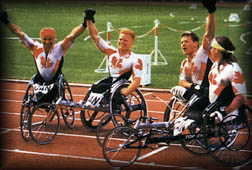

Athletes are making history in the world of sports for persons with a disability and Canada is among the top nations involved. In 1973, Eugene Reimer, (a paraplegic wheelchair athlete who won a number of world records) became Sport Canada's Male Athlete of the Year for 1972, an honour no other nation has ever bestowed on a disabled athlete.
Three years later, in 1975, the first tri-disability competitions were held in Edmonton, Alberta. They included the annual Wheelchair, Blind and Amputee Games.
In 1983, athlete Rick Hansen was honoured with the first Lou Marsh Special Award of Merit, (given to Canada's most outstanding athlete) for winning nine gold medals at the Pan American Wheelchair Games in Halifax, Nova Scotia.
The Ontario Ministry of Tourism and Recreation established the Dr. Robert Jackson Award for Ontario's Disabled Athlete of the Year in 1986. St. Catharines's Joanne Bouw, a cerebral palsy athlete was the first recipient, recognized for her accomplishments as a field event World Champion.
Sports for disabled athletes did not always have a high profile. Over the years they have gone through many changes, survived many obstacles. The earliest record of Sport for the Physically Disabled dates back to World War I when it was initiated as a form of treatment, especially among the blind and amputees servicemen. But the interest and enthusiasm among the disabled was not long lasting. Prior to 1940, medicine was able to do little for disabled persons, especially those who suffered spinal injuries. The majority of the spinal injured died a short time after their accidents from ensuing complications and sometimes from the loss of the will to live.
During World War II, with its large number of crippling casualties, the idea of sport as aid to treatment and rehabilitation was revived. But it was not until 1944, when the late Sir Ludwig Guttman, a specialist with spinal injuries, was appointed medical director of Stoke Mandeville Hospital by the British Government, that the sports took hold. Guttman was determined that spinal-injured soldiers should not only survive but function as full contributing members of society. To meet these high ideals, Guttman introduced sport into the rehabilitation program, primarily to train the body, and secondly to revive the spirit of accomplishment and self worth.
At Stoke Mandeville Hospital, he began with a few sports that included archery, snooker and table tennis. Interest skyrocketed as team sports of wheelchair polo and basketball were introduced. Sport for the disabled was off to a strong start.
A milestone event took place on July 28, 1948. Sixteen paralyzed British ex-servicemen and women engaged in an archery competition on the fields of Stoke. By doing so, this group was instrumental in changing the face of sports from rehabilitation to competition.
By 1952, Stoke Mandeville Games had become an International event with more than 130 competitors, an event that is held annually today. The greatest recognition for disabled athletes came in 1956. The Fearnley Cup, an Olympic Award for outstanding achievement in the service of the Olympic ideal, was presented to the Stoke Manville Games by the Olympic Committee during the Melbourne Games in Australia. Never before had it been presented to an organization for severely disabled people - people who only 20 years before had been considered hopeless outcasts from society.

Various offshoots of the original Games were designed to stimulate the development of sports for the disabled in North, Central and South America. In 1967, the first Wheelchair Pan American Games were held in Winnipeg, Manitoba, to do just that.
The Ontario Games for the Physically Disabled, first held in Cambridge in 1975, were designed with the Stoke Mandeville concept in mind. The goal being to assist athletes in their training and competitive development by providing opportunities for them to compete at National and International levels. From 1985, the Ontario Games were being held every two years but because of continuing enthusiastic interest and support, the Ministry of Tourism and Recreation announced in 1985 that they would again be held annually.
The first Canadian Cerebral Palsy National Games were held in Windsor, Ontario, in 1987. Since then, the Canadian Cerebral Palsy team and the Canadian Wheelchair team have claimed World titles, making Canada one of the top Nations in the World for disabled athletes.
Athletes participating in these Games are highly motivated. These Games offer the athletes a chance to qualify for a place on the Canadian team for the Paralympics.
At the International level, one of the largest competitions for the disabled was held in Long Island, New York, in 1984. It involved close to 3,000 athletes from 45 countries. Canada placed third overall winning 104 medals.
In Seoul, South Korea, in 1988, Canadian athletes finished fourth overall from among the 66 participating Countries.
The last International events were the Summer Paralympic Games in Barcelona, Spain, 1992, were Canada placed 7th, winning 75 medals and the Winter Games in Lillehammer,Norway 1994 were we placed 14th winning 8 medals.
The Paralympics are now awarded to the same city that is awarded the Olympics. All competitions are held in the Olympic venues and are conducted by Olympic officials. To complete in the Paralympics is the realization of every athlete's dream.
William Bishop is an associate writer for Cornerstones Magazine.